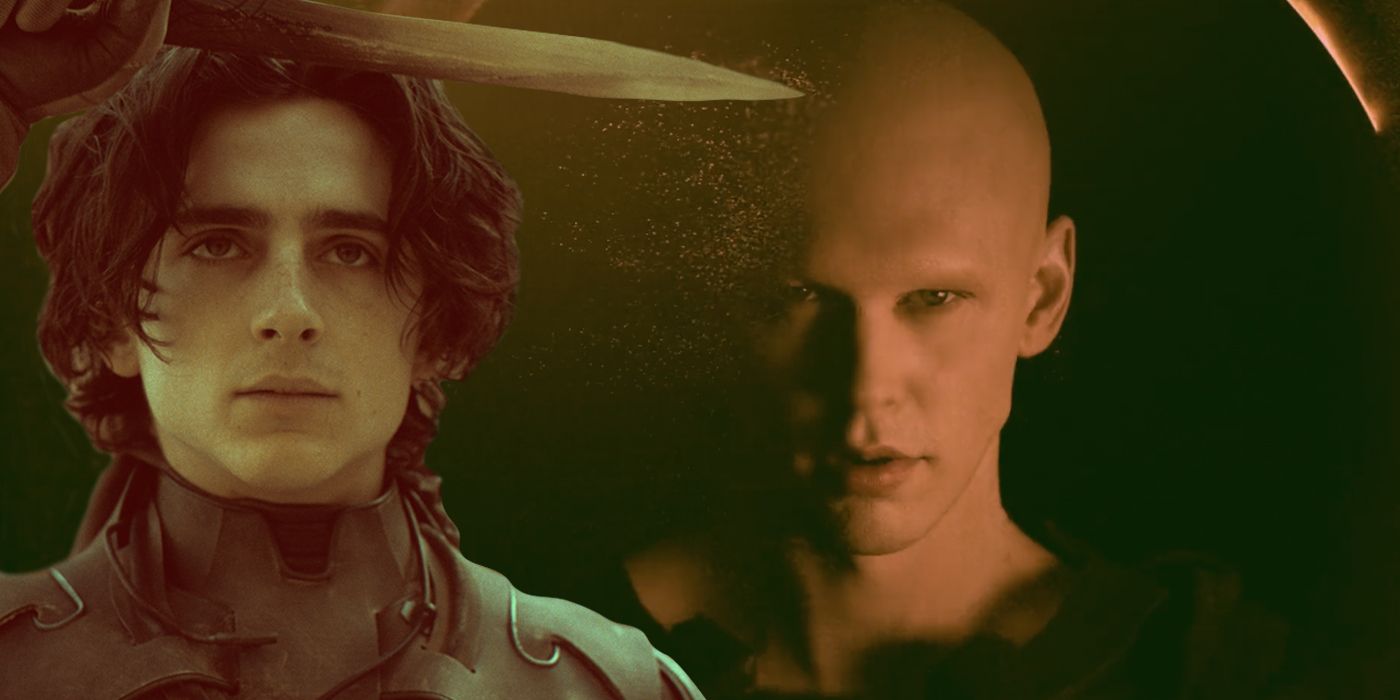Summary
-
Dune: Part Two
introduces viewers to close-quarters combat with futuristic technology and iconic duels between Paul and Feyd-Rautha. - The training fight foreshadows Paul’s fate and highlights his growth as a leader with excellent strategic skills in
Dune: Part Two
. - The final duel mirrors past battles, showing Paul’s evolution into a fearless warrior ready for intergalactic war in upcoming sequels.
Dune: Part Two brought a new style of cinematic combat to the sci-fi action genre. Amid the story of religious insurgency and manipulative prophecies is an all-out tale of intergalactic war. Despite the futuristic technology, the battles in Dune are fought in close quarters, with short knives and armor. Viewers are introduced to this concept in the exciting training fight between Gurney (Josh Brolin) and Paul Atreides (Timothée Chalamet) in Dune.
The scene introduces audiences to the shield technology that protects soldiers within the franchise. Viewers assumed the scene’s only purpose was establishing the technology and showcasing Paul and Gurney’s combat prowess. However, the unassuming scene plays a much larger role in the wider story and foreshadows Paul’s fate at the end of Dune: Part Two.
Paul Atreides Used Gurney’s Tactic in His Climactic Duel With Feyd-Rautha
Denis Villeneuve made a bold choice to close Dune: Part Two with a one-on-one duel. The entire film had been building up to a grand-scale clash between Paul’s Fremen army and House Harkonen, backed by the Emperor’s soldiers. Although we see glimpses of this battle, the true war is fought in a classic duel between Paul Atreides and Feyd-Rautha (Austin Butler). The duel is an expertly choreographed piece of action cinema. A constant back and forth highlights the skills of both characters, and it is frequently unclear who will best their opponent and win.
How Dune’s Marketing Tricked Audiences… Twice
Dune 2 repeated a sneaky trick from the first film, though it sets the stage for the eventual Dune: Messiah adaptation.
Towards the end, Feyd-Rautha gains the upper hand, slowly beating Paul’s defenses. Eventually, Feyd-Rautha lands (what he believes to be) the killing blow, stabbing Paul Atreides. Villeneuve keeps audiences on the path of believing this is how Paul will die. But Feyd-Rautha becomes overconfident. In doing so, he loses focus, and Paul quickly pulls the blade from his stomach and kills Feyd-Rautha with it. This scene draws obvious visual parallels with the training duel in Dune. That scene sees an overconfident Paul lose the fight as Gurney sneakily lands the killing blow after being knocked on his back.
“It’s a bit like a chess player who does several moves in advance to kill the king. It’s the same thing!”
Denis Villeneuve has stated he wanted the duels in Dune to feel like a chess match between two warriors. Both movies had already established that Paul and Feyd-Rautha were phenomenal physical fighters, meaning the final duel would come down to a battle of strategy. Feyd-Rautha stabbing Paul directly mirrors Paul knocking down Gurney. Both characters then stand confidently over their incapacitated opponent, expecting the kill to be definite and dropping their guards. Then, in a quick twist – which Villeneuve expertly hides with clever camerawork – the fate of the duel quickly shifts as Paul uses Feyd-Rautha’s hubris against him, just like Gurney did to him.
Dune: Part Two’s Duel Highlights Paul’s Growth as a Warrior and Leader
This parallel isn’t just a clever method of foreshadowing. It also highlights Paul’s strengths as a leader. Paul Atreides is reluctant to lead the Fremen for most of Dune: Part Two. This reluctance causes him to condemn his connections with Fremen prophecies and try to live humbly as a Fremen soldier with Chani. However, the duel exemplifies Paul’s intelligence, which is one of many reasons he is a natural leader.
Paul never makes the same mistake twice, and the parallels between these duels exemplify this quality. This fact is even proved in Dune. Paul’s duel with the Fremen soldier, Jamis, shows that Paul has already learned from his training with Gurney. Despite having the opportunity to kill Jamis on multiple occasions, he doesn’t proceed with the same arrogance he did in training and keeps his guard up.


How a Beloved Anime Film Paved the Way for Dune 2
This cult-classic anime unknowingly inspired Denis Villeneuve when creating Dune: Part Two.
Paul’s duel with Jamis is also thematically linked to Dune: Part Two‘s final fight. Paul Atreides was reluctant to kill Jamis, offering the Fremen the chance to yield on multiple occasions. During that scene, Lady Jessica (Rebecca Ferguson) notes that Paul has never killed a man. After Paul defeats Jamis, his remorse and guilt for killing someone is instantaneous. However, Dune: Part Two shows Paul has outgrown this moral blockade and is willing to do whatever it takes to lead the Fremen to true freedom. Paul isn’t overcome with grief and guilt after killing Feyd-Rautha. Instead, his attention directly turns to the Emperor, whom he forces to kiss his father’s ring in a display of dominance and victory.
The final duel in Dune: Part Two doesn’t just call back to Paul’s training duel; it has long-lasting implications for the franchise’s future. The eagerly anticipated Dune: Messiah will wrap up Denis Villeneuve’s trilogy and truly flip the audience’s perspective on Paul as the franchise’s hero. Following the duel, Paul has now enveloped the Fremen in an intergalactic war. The film’s dramatic close sees Paul Atreides lead his armies into space to attack the great houses. Dune: Part Two is playing in theaters now.
This story originally appeared on Movieweb

